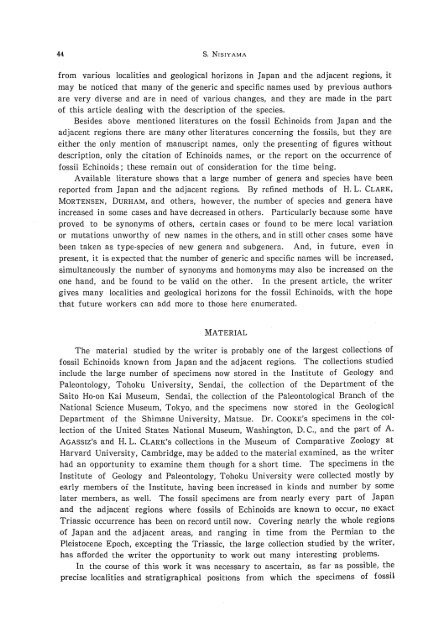the echinoid fauna from japan and adjacent regions part i
the echinoid fauna from japan and adjacent regions part i
the echinoid fauna from japan and adjacent regions part i
You also want an ePaper? Increase the reach of your titles
YUMPU automatically turns print PDFs into web optimized ePapers that Google loves.
44 S. NISIYAMA<br />
<strong>from</strong> various localities <strong>and</strong> geological horizons in Japan <strong>and</strong> <strong>the</strong> <strong>adjacent</strong> <strong>regions</strong>, it<br />
may be noticed that many of <strong>the</strong> generic <strong>and</strong> specific names used by previous authors<br />
are very diverse <strong>and</strong> are in need of various changes, <strong>and</strong> <strong>the</strong>y are made in <strong>the</strong> <strong>part</strong><br />
of this article dealing with <strong>the</strong> description of <strong>the</strong> species.<br />
Besides above mentioned literatures on <strong>the</strong> fossil Echinoids <strong>from</strong> Japan <strong>and</strong> <strong>the</strong><br />
<strong>adjacent</strong> <strong>regions</strong> <strong>the</strong>re are many o<strong>the</strong>r literatures concerning <strong>the</strong> fossils, but <strong>the</strong>y are<br />
ei<strong>the</strong>r <strong>the</strong> only mention of manuscript names, only <strong>the</strong> presenting of figures without<br />
description, only <strong>the</strong> citation of Echinoids names, or <strong>the</strong> report on <strong>the</strong> occurrence of<br />
fossil Echinoids; <strong>the</strong>se remain out of consideration for <strong>the</strong> time being.<br />
Available literature shows that a large number of genera <strong>and</strong> species have been<br />
reported <strong>from</strong> Japan <strong>and</strong> <strong>the</strong> <strong>adjacent</strong> <strong>regions</strong>. By refined methods of H. L. CLARK,<br />
MORTENSEN, DURHAM, <strong>and</strong> o<strong>the</strong>rs, however, <strong>the</strong> number of species <strong>and</strong> genera have<br />
increased in some cases <strong>and</strong> have decreased in o<strong>the</strong>rs. Particularly because some have<br />
proved to be synonyms of o<strong>the</strong>rs, certain cases or found to be mere local variation<br />
or mutations unworthy of new names in <strong>the</strong> o<strong>the</strong>rs, <strong>and</strong> in still o<strong>the</strong>r cases some have<br />
been taken as type-species of new genera <strong>and</strong> subgenera. And, in future, even in<br />
present, it is expected that <strong>the</strong> number of generic <strong>and</strong> specific names will be increased,<br />
simultaneously <strong>the</strong> number of synonyms <strong>and</strong> homonyms may also be increased on <strong>the</strong><br />
one h<strong>and</strong>, <strong>and</strong> be found to be valid on <strong>the</strong> o<strong>the</strong>r. In <strong>the</strong> present article, <strong>the</strong> writer<br />
gives many localities <strong>and</strong> geological horizons for <strong>the</strong> fossil Echinoids, with <strong>the</strong> hope<br />
that future workers can add more to those here enumerated.<br />
MATERIAL<br />
The material studied by <strong>the</strong> writer is probably one of <strong>the</strong> largest collections of<br />
fossil Echinoids known <strong>from</strong> Japan <strong>and</strong> <strong>the</strong> <strong>adjacent</strong> <strong>regions</strong>. The collections studied<br />
include <strong>the</strong> large number of specimens now stored in <strong>the</strong> Institute of Geology <strong>and</strong><br />
Paleontology, Tohoku University, Sendai, <strong>the</strong> collection of <strong>the</strong> De<strong>part</strong>ment of <strong>the</strong><br />
Saito Ho-on Kai Museum, Sendai, <strong>the</strong> collection of <strong>the</strong> Paleontological Branch of <strong>the</strong><br />
National Science Museum, Tokyo, <strong>and</strong> <strong>the</strong> specimens now stored in <strong>the</strong> Geological<br />
De<strong>part</strong>ment of <strong>the</strong> Shimane University, Matsue. Dr. COOKE'S specimens in <strong>the</strong> col-<br />
.lection of <strong>the</strong> United States National Museum, Washington, D. C., <strong>and</strong> <strong>the</strong> <strong>part</strong> of A.<br />
AGASSIZ'S <strong>and</strong> H. L. CLARK's collections in <strong>the</strong> Museum of Comparative Zoology at<br />
Harvard University, Cambridge, may be added to <strong>the</strong> material examined, as <strong>the</strong> writer<br />
had an opportunity to examine <strong>the</strong>m though for a short time. The specimens in <strong>the</strong><br />
Institute of Geology <strong>and</strong> Paleontology, Tohoku University were collected mostly by<br />
early members of <strong>the</strong> Institute, having been increased in kinds <strong>and</strong> number by some<br />
later members, as well. The fossil specimens are <strong>from</strong> nearly every <strong>part</strong> of Japan<br />
<strong>and</strong> <strong>the</strong> <strong>adjacent</strong> <strong>regions</strong> where fossils of Echinoids are known to occur, no exact<br />
Triassic occurrence has been on record until now. Covering nearly <strong>the</strong> whole <strong>regions</strong><br />
of Japan <strong>and</strong> <strong>the</strong> <strong>adjacent</strong> areas, <strong>and</strong> ranging in time <strong>from</strong> <strong>the</strong> Permian to <strong>the</strong><br />
Pleistocene Epoch, excepting <strong>the</strong> Triassic, <strong>the</strong> large collection studied by <strong>the</strong> writer,<br />
has afforded <strong>the</strong> writer <strong>the</strong> opportunity to work out many interesting problems.<br />
In <strong>the</strong> course of this work it was necessary to ascertain, as far as possible, <strong>the</strong><br />
precise localitIes <strong>and</strong> stratigraphical 'positions <strong>from</strong> which <strong>the</strong> specimens offossB












